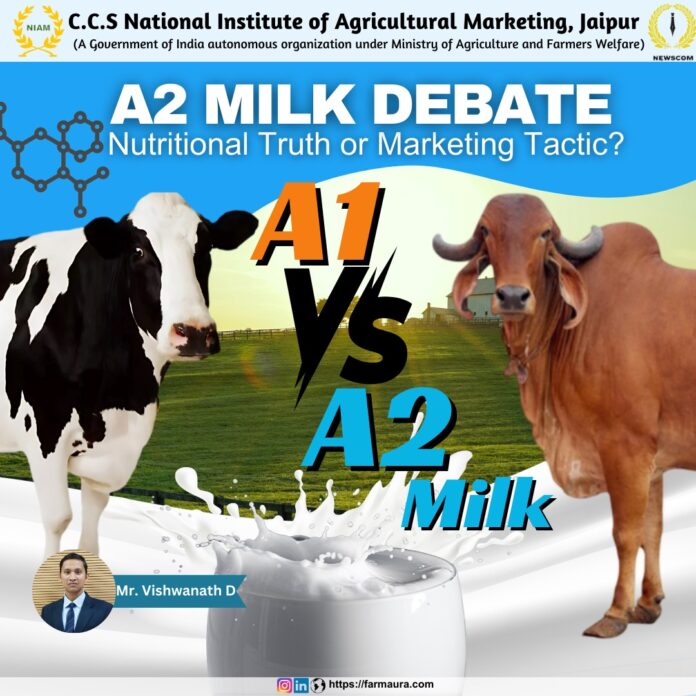MILK is an enormously evolved secretion of mammary glands produced by mammals, being the perfect food for novices. Globally, India is the highest milk producer (176.4 million tonnes) and consumer, neither exports nor imports milk. For a long time, milk has been considered a complete source of nutrients (both micro and macronutrients), providing a range of proteins, carbohydrates, and other important components of human food. Around the World, cows, buffalo, sheep, camels, and goats are known as the main producers of milk, out of which cows are the major producers of milk, i.e., 83% (about 600 million tonnes) of the total milk produced annually. Also, India is the leading milk producer (approximately 176.3 million tonnes), the highest in the World. In India alone, 46.9% of milk is yielded by buffalo, while cattle produce 49% of milk.

Source: ICAR – Central Institute for Research on Cattle, Meerut 250 001, Uttar Pradesh
What is A1 and A2 Milk?
Milk protein is divided into two significant classes, i.e., casein and whey protein. The casein is further subdivided into alpha, beta, and kappa casein, out of which beta-casein is more ubiquitous, containing balanced proportions of essential amino acids. Different mutations in the bovine beta-casein gene have led to 12 genetic variants, and out of these, A1 and A2 are the most common. The A1 and A2 beta-casein variants differ at amino acid position 67 with histidine (CAT) in A1 and proline (CCT) in A2 milk due to single nucleotide difference.
Why does this difference matter?
A1 Milk: Predominantly derived from European breeds such as Holstein Friesian, Over the period, A1 milk has become the most commonly consumed in India. A high content and calorie content characterizes it. However, it may cause digestive issues such as bloating and irritable bowel syndrome in some individuals due to its unique protein structure.
A2 Milk: Milk obtained from indigenous breeds like Gir, Sahiwal, and Tharparkar is A2 milk. It contains less fat, more proteins, and beneficial omega-3 fatty acids. It is associated with lower cholesterol levels, and potassium helps maintain healthy blood pressure.
Scientific Studies and Skepticism:
The health debate between A1 and A2 milk primarily revolves around the peptide beta-casomorphin-7 (BCM-7), released during the digestion of A1 milk. Studies have suggested that BCM-7 may contribute to a range of health issues, including inflammatory responses, digestive disorders like bloating, irritable bowel syndrome (IBS), diarrhoea, and even more systemic conditions. BCM-7 has been linked to an increased risk of Type 1 diabetes, cardiovascular issues, and neurological disorders such as autism, schizophrenia, and developmental
In contrast, A2 milk contains the amino acid proline, which prevents the release of BCM-7 and potentially harmful effects. While these claims have fueled the marketing of A2 milk as a healthier alternative, the scientific evidence remains limited and inconclusive. Some studies support the potential risks associated with BCM-7, but many fail to establish clear causation. Similarly, the purported benefits of A2 milk are mainly anecdotal and lack consistent validation through robust clinical research. The controversy remains unresolved, emphasizing the urgent need for more comprehensive, large-scale studies to clarify the health impacts of A1 and A2 milk.
The Battle Begins:
The A1 vs. A2 milk debate came to light when BCM-7, a peptide that may cause health problems and is found in A1 milk, was researched. Since A2 milk does not break down BCM-7, it became a healthier option in the market. The controversy gained momentum in the 1990s when New Zealand dairy companies marketed A2 milk in a saturated market, using anecdotal evidence and limited studies to attract health-conscious consumers. This polarized opinions, with advocates highlighting health benefits and critics questioning the evidence. The dairy industry is still somewhat divided between the consumer demands, marketing tactics, and the necessity for more science-based information.
Marketing and Controversy:
The commercial interests have made the A2 milk debate position A2 milk as a premium product with health benefits, which leads to a much higher price than regular milk. In India, A2 milk is 2-3 times more expensive, and A2 ghee is up to 10 times more expensive, with almost negligible differences in protein content. Startups justify the pricing by ethical practices like feeding calves before milking and using low-yield breeds like Gir and Sahiwal. These sustainable practices raise costs, and therefore premium pricing is essential. The A2 label increases the export of Indian dairy worldwide to health-conscious consumers willing to pay more.
Regulatory Actions:
India’s FSSAI recently notified food businesses to stop marketing milk as A1 or A2, claiming that such labels mislead consumers. However, after pushback from organizations like ICAR (Indian Council of Agricultural Research), FSSAI reversed its decision and decided to consult with stakeholders on how to regulate milk branding.
Most milk in India is naturally A2, primarily sourced from indigenous breeds like Gir, Sahiwal, and Tharparkar, which produce only A2 milk. Only after the White Revolution in the 1970s did European breeds like Jersey and Holstein Friesian, which produce A1 milk, crossbred with native cows. However, these crossbred cows comprise only a tiny portion of India’s dairy production. So, most milk consumed in India is likely A2, even without being labelled as such.
The FSSAI’s decision to backtrack shows the issue’s complexity, as the A2 label could offer a competitive edge for India’s growing dairy exports. Thus, the regulator’s approach will have global implications, and it plans to involve all stakeholders in deciding how to handle milk branding moving forward.
Conclusion:
The debate between A1 and A2 milk has sparked considerable interest, driven by claims about their health benefits and potential risks. However, scientific evidence on the distinct advantages of A2 milk remains inconclusive, with many studies failing to show significant differences between the two. Consumers should focus on factors like fat content, vitamin fortification, freshness, and organic sourcing when choosing their milk rather than solely relying on the A1 vs. A2 distinction.
Ultimately, the decision depends on personal preferences, dietary needs, and ethical considerations. As the dairy industry continues to evolve, consumers must make well-informed choices based on the available research and their individual health goals.




